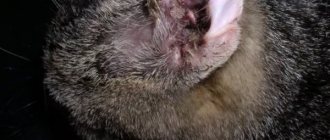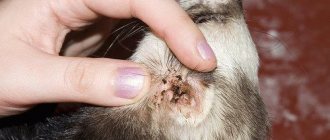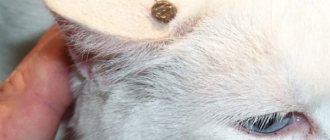Ear mites in kittens and adult cats are not so rare. In the absence of timely, qualified treatment, a pet can not only lose hearing, but also die. That's why it's important to keep an eye on your animal: if your cat is shaking its head and scratching its ears, it's time to check it for ticks.
What does an ear mite look like in cats?
Mites in the ears of cats are a disease called otodectosis. The disease can manifest itself not only in street cats, but also in domestic fluffies. It should be noted that kittens are most susceptible to the disease.
The parasite actively feeds on particles of the dermis. As a result, severe itching begins, which gives the cat no rest. She begins to behave differently, she may lose appetite and sleep, or, conversely, be constantly lethargic.
At the initial stage, ear mites in a cat look like ordinary dirt. Many breeders are unaware of the disease. If you carefully examine the auricle, you will notice dark, thick deposits with an unpleasant odor. What does ear mites look like in cats if the disease starts? This is a severe inflammation inside the ear, covered with a dark brown crust. At this stage, serious treatment is required.
Initially, the animal will not show any reactions. However, as the parasites spread, the infected person becomes increasingly restless. You may notice the cat shaking its head or constantly scratching - severe itching affects the entire top of the head.
If you look at the parasites under a microscope, you can see that the mites in the ears of cats are about 0.2 - 0.7 mm in size. Their body shape is elongated, oval. The proboscis is located on the head part. Short limbs and a pale yellow tint of the body indicate a pest that lives on the inner area of the ear, and sometimes on the eardrum. The infection development cycle itself is completed in fourteen days. The parasite is able to easily pass from one animal to another, including dogs and other pets.
Causative agent of demodicosis
Demodex is a very small mite, only 0.5 mm long. It has an elongated transparent body with unclear boundaries between the cephalothorax and abdomen. Ticks have small legs with hooks at the ends. The oral apparatus is equipped with a proboscis.
The mite lives near the hair roots and in the sebaceous glands. There it eats dead cells and sebum and actively reproduces. Outside the animal's body, the tick dies in about 2 hours.
From egg to adult, the parasite goes through the following stages:
- larva;
- protonymph;
- deutonymph.
The tick can live in active and passive forms. In the first case, it feeds and increases in size, and in the second, it becomes motionless. The duration of the entire biological cycle is 23 days (on average). During 3 months of illness, a cat grows 3 generations of mites.
Some sources claim that Siamese and Burmese cats experience demodicosis more often than other members of the family.
Why is otodectosis dangerous?
In most cases, two ears are affected at once. The possibility of infection increases during warm and humid periods of the year. Small kittens and weak pets are at risk. Interestingly, it can take a year from the moment of infection to the appearance of the first signs. The disease will become noticeable when a bacterial infection is attached to it. The furry friend will constantly experience discomfort, will not eat, sleep, and will start shaking his head.
The ear will scratch due to unbearable itching. This damages the capillaries and leads to the appearance of large hematomas. In the area where the skin has been damaged, infection in the form of bacteria or fungi penetrates. The inflammatory process starts, tissue swelling, redness, and pus appear.
If the inflammation is not stopped, it will spread to the eardrum, and this can lead to weakening or loss of hearing. At this time, your furry friend will behave irritably, nervously, even aggressively. Over time, inflammation can reach the head. The prognosis in these cases will be disappointing - the pet may die from the tumor.
It is important to avoid complications. If you notice deviations similar to the symptoms of otodectosis, contact a professional doctor immediately.
Symptoms of the disease
Infestation with subcutaneous mites can be identified by the following manifestations:
- oozing nodules or bumps on the skin;
- redness on the body, changes in skin pigmentation;
- skin thickening;
- focal hair loss;
- “demodicosis glasses” - the cat loses hair around the eyes;
- peeling and itching of the skin;
- bleeding wounds;
- deterioration of health.
Photo gallery: signs of activation of the subcutaneous mite
Red bumps on the skin - a concentration of subcutaneous mites
Due to inflammation and strong friction during scabies, areas of the skin turn red
Hair loss is one of the main symptoms of subcutaneous mite infestation.
Hair loss around the eyes is a marker of demodicosis
Severe itching is the first sign of a tick-borne infection
With mild local forms of damage, self-healing is possible.
In particularly severe forms of the disease, intoxication of the entire cat’s body occurs with waste products of the tick. In this case, complications are possible in the form of:
- further decrease in immunity;
- decreased skin barrier function;
- formation of purulent foci;
- enlarged lymph nodes.
How do you get infected with otodectosis?
Ear mites in cats can appear if the animal has been walking outside and has been in contact with other cats. Most homeless animals suffer from otodectosis. If you let your pet outside, you should carefully examine it after a walk and do not neglect the rules of hygiene.
There is a possibility of introducing ticks on shoes or clothes. The owner can pet an infected feline or simply walk past a pack of stray animals - and this will be enough for the parasite to travel to a completely domestic cat.
There is a high risk of the disease appearing in those homes where similar cases have already occurred. Ear mites in a kitten are transmitted from the mother, as well as through carpets, various products, home furniture - everything that can accumulate dust particles and microorganisms.
Routes of transmission of ticks from one individual to another
The most common variant of infection is contact with already sick animals. It is enough for one cat to sniff another for several parasites to leave the host and be transmitted to a healthy animal. But there are also indirect methods of infection.
Cat ear mites live up to two months in their natural environment, which means they can be picked up through indirect contact. The disease is transmitted through care products: scratchers, carriers, bedding. Sometimes the infection is carried by fleas or flies.
If a room is not regularly cleaned, the mite settles there, waiting for a host. This should be taken into account when moving or when leaving a cat as a guest for a while.
At elevated temperatures the parasite lives even longer. It stays on clothing and shoes. Therefore, it is important to protect your cats from contact with outdoor shoes and outerwear - ideally, there should be a closed closet in the apartment.
To summarize, we can say that the main “helper” of otodectosis infection is unsanitary conditions. A domestic cat that is carefully cared for, vaccinated and kept clean has the least chance of getting sick.
Progression of the disease in stages
Otodectosis is the most popular skin disease. Ear mites in cats are diagnosed in 85% of cases when breeders treat suspected otitis media. The carpet beetle corrodes the upper surfaces of the epidermis, located on the inside of the shell. The disease proceeds as follows:
- Mechanical injury. At this point, the upper layers of the dermis are damaged. With its powerful mouthparts, the parasite chews the surface, obtaining blood and lymph. The nerve endings become irritated, resulting in severe itching.
- Blood vessels begin to thin out. They become filled with blood, redness and swelling appear.
- You may notice persistent discharge in areas of damaged skin.
- Dark brown scabs form from dead skin cells, as well as other waste products of pests. The whole process is accompanied by the formation of putrefactive microflora.
- There is a gradual accumulation of scabs and crusts, which leads to the formation of a plug. Hearing begins to become dull. If measures are not taken, the eardrum will rupture. The infection opens up to the middle and inner ear.
If parasitosis is advanced, then an active inflammatory process develops in the inner and middle ear. The symptom is a certain behavior of the animal: the sick person walks with his head turned 90 or even 120 degrees. The ear that hurts will point downwards. This process leads to the spread of pathology to the membranes of the brain, sepsis and, as a result, death.
Breeders need to remember that such a simple disease can result in disastrous consequences. But even in advanced cases, it is possible to successfully treat ear mites in a cat and avoid serious consequences.
Path of infection
Otodectosis often affects cats; dogs, foxes, and ferrets can also suffer; quite rare, but the disease is recorded in rodents (guinea pigs, rats, hamsters) and lagomorphs (rabbits).
Infection mainly occurs through contact with a carrier animal - in crowded conditions, in contact with street animals, kittens can become infected from the mother cat.
Cats that have access to the outdoors are often infected with the disease.
Infection can also occur through contact with bedding and beds infested with eggs or mites, through the owner’s clothing or the pet’s toys. It is extremely rare that ear mites can cause otitis even in humans.
The disease has no seasonality ; an animal can become infected at absolutely any time of the year, but is more often recorded in warm weather (since ticks persist longer in the environment).
Up
Symptoms and diagnosis
The owner’s attention is the key to ensuring that any disease is suppressed in the bud in a timely manner. Ear mites are not the most difficult disease to recognize. So it won't be difficult to notice him.
When there is suspicion of otodectosis
You should suspect otodectosis if your furry friend begins to itch frequently. Infection can be determined externally:
- restlessness and shaking of the head, as if a furry friend is trying to throw off some kind of burden;
- dirty brown liquid in the ear canal – it will have a pungent odor;
- the auricle turns red - this is how irritation manifests itself;
- hair may fall out on the outside of the ear and purulent ulcers may appear;
- body temperature periodically rises, accordingly, the animal becomes lethargic - this is the stage of inflammation;
- hearing is partially or completely lost;
- impressive accumulations of sulfur and brown discharge are noticeable;
If the temperature is normal, the pet may meow, run from room to room, and show severe anxiety. In complicated forms, the head begins to tilt towards the affected ear, and the cat itself falls into an apathetic state, loses appetite and moves little. Immediately contact a professional who will help you deal with the situation quickly.
Diagnosis by a veterinarian
Only a qualified veterinarian will determine how to treat ear mites in cats. Before visiting a doctor, the owner can only determine the presence of pests. To do this you will need a cotton swab and a piece of dark fabric:
- use a stick to remove as much of the mass as possible from the ear;
- tap with a stick over a dark surface to shake off pests;
- A bright light is directed onto the area being examined;
- Under a magnifying glass they examine the consistency of the mass: the moving yellowish dots are mites.
Next, you need to urgently go to the doctor. The effectiveness of treatment always depends on how soon the owner seeks professional help. Even if you know traditional methods, you should still ask your doctor how to cure ear mites in cats.
In addition, the veterinary hospital will conduct an examination, a microscopic examination, take a scraping and check the hearing organs. This will not only confirm the diagnosis, but also establish the stage of the disease. According to the neglect, treatment will be prescribed.
Cleaning ears at the veterinary clinic
The list of services provided by veterinary clinics includes a hygienic procedure - ear cleaning.
Veterinarians believe that it is necessary to carry out a professional examination of the animal at least once every two weeks, so that if any disease is detected in it, they can provide the animal with timely qualified assistance and prevent complications.
How much does it cost to clean a cat's ears at the vet? clinic, depends on the neglect of the case and on the pricing policy of the institutions themselves.
A loving, good owner takes care of his pet, regularly monitors its health and, if necessary, will always seek qualified help from a veterinary clinic.
Therapy and care
Many people are interested in how to treat ear mites in cats if there are other animals in the house? First, you need to isolate the sick person from other animals, throw out all bedding, rugs and other textiles on which the cat was located from the house. The apartment is thoroughly washed with disinfectants. The treatment of a sick animal is carried out wearing gloves and clothing that is not taken out of a closed room or closet.
The main rules for treating ear mites in cats include the following:
- If there are several furry inhabitants (cats or dogs) in the house, then everyone will have to be treated - regardless of whether they have the disease or not. For kittens and pregnant animals, it is worth using a gentle spray.
- Don’t forget about careful cleaning of your home. It is better to throw away bedding and rugs, or, as a last resort, boil them.
- It is worth remembering that a pet’s recovery directly depends on the strength of its immunity. Provide the patient with balanced, high-quality food and include vitamins in the diet.
- Clean your home more often. Remember that harmful microorganisms settle on various objects, in cracks in the floor, in fabrics and even in books.
- Never use products containing ethyl alcohol to treat ear mites in cats.
The duration of treatment for ear mites in cats will depend on the degree of neglect of the disease and on the drugs chosen. Simple cases can be resolved in one to three weeks. But in case of complications, when there is a secondary infection, the treatment process will drag on for several months.
Hygiene procedures and processing
All medications will be prescribed by a doctor. He will also tell you about the treatment regimen. Further actions will be approximately as follows:
- First of all, the surface of the ears is cleaned of crusts and dried particles, and the hair that gets in the way is trimmed.
- Warm hydrogen peroxide is carefully and slowly injected using a syringe. 2-3 ml is enough. You have to wait 15 minutes. You can replace this substance with olive oil.
- Using tweezers and a cotton swab, carefully clean out all the secretions. Dirty swabs are placed in a closed container. After completing the manipulations, they must be burned.
- After the ear canal has been thoroughly treated, 1-2 ml of acaricidal liniment or solution prescribed by a veterinarian must be administered, heated to 32 degrees (slightly warmer than room temperature).
- The auricle is bent and a small massage is given for about five minutes.
- Acaricidal powders are blown into each auditory organ or special aerosols and drops are used.
Such manipulations are repeated three times every week, but the exact schedule of procedures will be drawn up by a veterinarian. External cleaning of the ears is carried out daily.
Drug treatment
There are various medications for ear mites in cats, produced in Russia and abroad. The most popular are ointments for ear mites in cats or drops. There are also sprays that can be used to treat bedding, the cat’s body and its “personal items”. The ointment has the longest working time, but it is not as easy to apply as drops or spray. What remedies for ear mites in cats in the form of drops does modern pharmacology offer:
1. Amitrazine
. It is quite popular because it has a triple therapeutic effect: it destroys infections, fungal infections and subcutaneous pests. The substances begin to act immediately after instillation. This option is considered less toxic. The positive thing is that there are no negative effects.
2. Otoferonol
. This option is similar to the previous one. This is an excellent substance for ear mites in cats. Drops have low toxicity. They are comfortable and safe to use for treating kittens. It is only important to dose and apply the substance correctly. This drug must be injected into two hearing organs at once, even if only one is damaged.
3. Tsipam
. The medication has no side effects or contraindications. If the intervention is started in a timely manner, the treatment can be carried out only once. If the disease is advanced, you will have to repeat the manipulations every week until the condition finally improves.
4. Drops Bars
. They are instilled directly into the auditory organ, 3 ml each. If purulent inflammation is present, the dosage is increased. The areas need to be treated for seven to ten days intermittently. However, side effects often occur due to individual sensitivity.
Use ointment as an aid. The doctor will prescribe Aversectin ointment, Amidel-gel. Vedinol Plus, Ordermil.
Acaricidal powders are also used in veterinary medicine
:
- Phenothiazine
. It has a light yellow tint and a weak specific odor. The substance has a strong acaricidal, antimicrobial and anthelmintic effect. The drug is low-toxic and can be stored in closed packaging for quite a long time without losing its properties.
- Fine sulfur.
Light yellow powder that is insoluble in water. It should be used as part of a set of measures when infected with mites or fungi. The product can be purchased at any veterinary pharmacy, the drug is widely available.
A small dose of powder is poured into the hearing organ using paper. The advantage of the powder is its uniform distribution, the disadvantage is that it is quite difficult to apply. If your cat does not tolerate treatment procedures well, it is best to stop with drops.
Radical methods of therapy include the special antiparasitic drug Ivermectin, which is administered subcutaneously. The instructions contain the exact dosage, calculated based on the weight of the animal. This substance is very toxic, so it is prohibited for use outside veterinary clinics. It should not be used for small kittens, pregnant or weakened animals.
If otodectosis is advanced and signs of meningitis appear, then antibiotics, immunomodulatory elements, and vitamins are used for treatment. Such a “severe” patient is usually admitted to a hospital.
Folk remedies: useful and dangerous
At the first signs of otodectosis, you can try using folk remedies. In this case, it is necessary to carefully monitor the entire process so as not to prolong the disease. Before starting home therapy, be sure to consult with a veterinarian - you can call the veterinary clinic and agree on treatment measures over the phone.
Popular options include almond butter and strong green tea. They are used to treat mite-affected areas. It is important to observe personal hygiene measures here: carry out all manipulations only with special gloves. It is worth doing the procedures regularly, otherwise they will not give results.
All products must be fresh and at a comfortable temperature. To do this, they are slightly heated.
It must be remembered that some folk remedies for ear mites in cats can cause harm rather than benefit. For example, some owners prefer to use soda or crushed garlic, but they can lead to poisoning. Even worse is to use celandine, since it is extremely toxic not only to pests, but also to animals.
To avoid harming your pet, consult your doctor about each decoction or drug. Ideally, folk remedies should be combined with medications - only then the treatment will bring quick and positive results.
Danger to humans and other animals
Many owners fear that ear mites are dangerous to humans. However, otodectosis is not transmitted to people or even small children. But for other pets the disease is dangerous, as it is easily and quickly transmitted.
It is worth remembering that a person can become a carrier of parasites without getting sick. Therefore, it is easier to keep the house clean and care for your pet than to treat it later.










